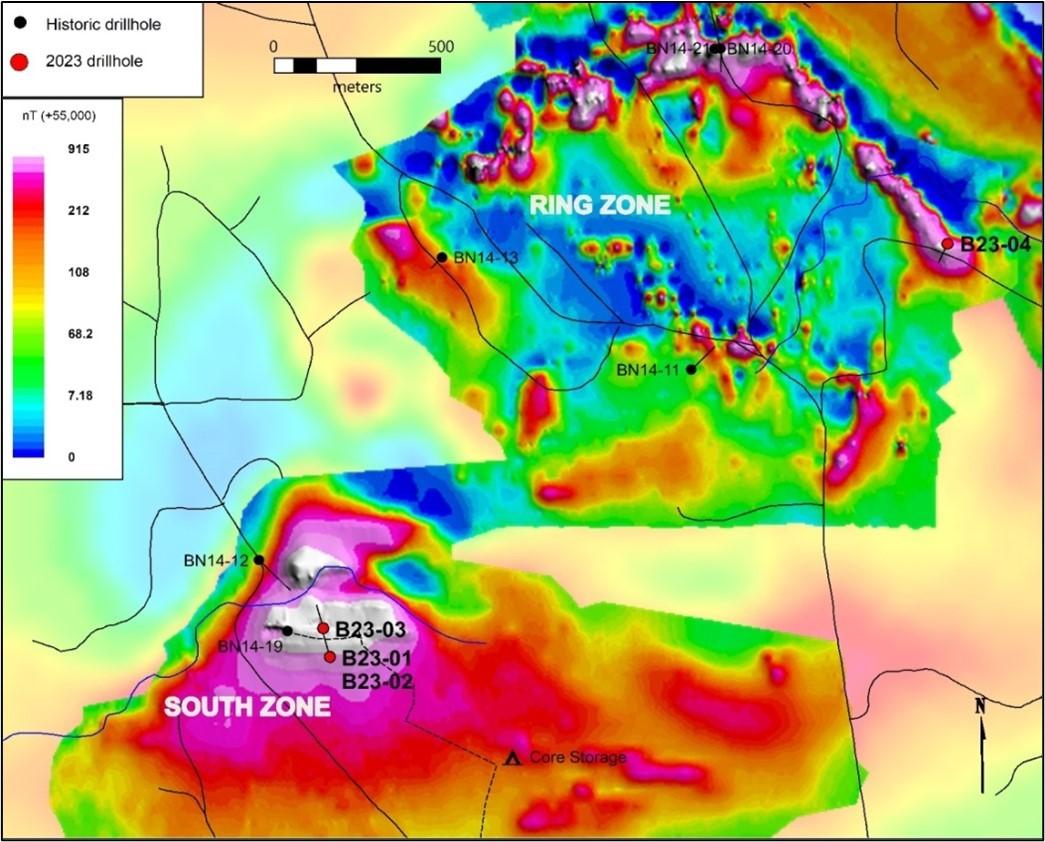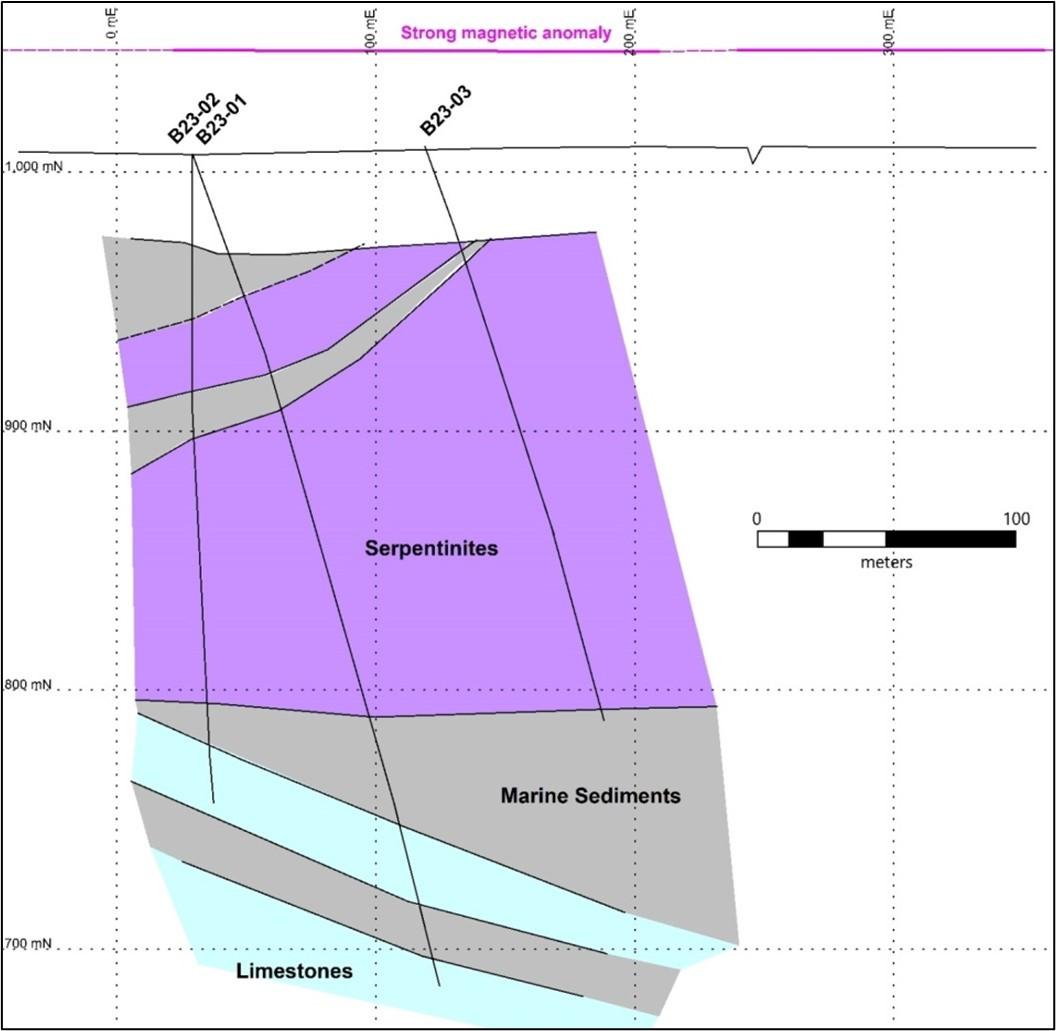
Inomin Drills 23% Magnesium and 0.19% Nickel Over 179 Metres at Beaver South Confirming Large Deposit Potential
Ring Zone Drilling Intersects 22% Magnesium and 0.18% Nickel Over 112 Metres Just 20 Metres from Surface
Inomin Mines Inc. (TSX-V: MINE) is pleased to report that drilling at the South and Ring Zones of the Beaver-Lynx critical minerals project, continues to intersect high-grade magnesium and nickel over long intersections. South Zone drill-hole B23-03, located 100 metres north of hole B23-02, intersected 23% magnesium with 0.19% nickel over 179.2 metres, the longest intersection from drilling in the South Zone to date. Drill hole B23-04, testing the eastern portion of the Ring Zone 2.3 kilometres northeast, intersected 22.3% magnesium with 0.18% nickel over 112.2 metres, with mineralization beginning at bedrock surface.
Summary 2023 Spring Drilling Results – South and Ring Zones, Beaver Property
“Inomin’s spring drilling at Beaver has confirmed the discovery of a large magnesium-nickel mineralized body at the South Zone and achieved the best drilling result from the Ring Zone to date,” says John Gomez, President of Inomin. “Our exploration has grown discoveries at Beaver to six potentially large deposits and confirms the project’s excellent potential for hosting near-surface, bulk-tonnage deposits. We’ve also identified new prominent exploration targets to continue to increase Beaver’s mineral footprint. Additionally, we have several compelling targets at the yet to be drilled Lynx area. If drilling at Lynx achieves results comparable to Beaver, we are looking at a district-scale critical minerals system.”
The spring drill program drilled a 3-hole fence across the strongly magnetic area defining the South zone. Locations of the drillholes are illustrated in Figure 1. Drilling intersected magnesium-nickel mineralization in two shallowly south dipping bodies with a combined estimated true thickness of 160 metres (Figure 2), with thickness increasing to the north. Historic drillholes BN14-12 and BN14-19, drilled approximately 120 metres west of the 2023 drillholes, intersected 21% magnesium and 0.18% nickel over 86.0 m and 22.3% magnesium and 0.18% nickel over 147.8 metres respectively.
The current density of drilling at the South zone has defined an approximate 150 x 200 x 160 metre body containing fairly consistently distributed magnesium and nickel mineralization. Magnetics suggests that mineralization likely extends an additional 250 metres to the north, 120 metres to the south, and 225 metres east of current drill testing.
The Ring Zone is a 1,500 x 1,800 metre ring-shaped magnetic zone, 500 metres northeast of the South Zone. The 2023 drilling results are relatively in line with the Company’s 2021 drilling results, characterized by long intersections of consistently distributed near-surface mineralization
Figure 1. 2023 Drillhole locations – Beaver Area
Figure 2. Cross-section illustrating 2023 drilling results in the South Zone (looking west).
Future drilling at Beaver-Lynx will focus on additional targets at Beaver and maiden drilling at the 13,610-hectare Lynx area located ten kilometres south of Beaver. Lynx is geologically similar to Beaver with even more and larger prospective mineral targets. Airborne magnetics delineated numerous strong linear magnetic anomalies often extending multiple kilometres in length (Figure 3). Like the Beaver area, the Lynx property shows potential for hosting several bulk-tonnage, magnesium-nickel deposits. Initial exploration completed at Lynx consists of prospecting as well airborne and ground magnetic surveys.
Figure 3. Lynx Area showing 2022 ground magnetics overlaid on 2014 airborne magnetics (TF).
Laboratory Analysis of Drill Core
Drill core was analyzed using Actlab’s FUS-Na2O2 20-element sodium peroxide fusion ICP-OES method. Samples were dried, crushed (<7 kg) to 80% passing 2mm (10 mesh), riffle split 250g and pulverized (mild steel) to 95% passing 105µm (150 mesh) including cleaning the pulveriser bowl with sand after each sample (Method code RX1). Samples were then digested with a sodium peroxide fusion, acid dissolution followed by ICP-OES finish.
Conventional QAQC protocols were adopted in the field including the introduction of field standards and blanks in the sample stream to the laboratory.
About Beaver-Lynx Critical Minerals Project
The Beaver-Lynx property, comprising approximately 22,600 hectares, is ideally located in south-central British Columbia, 50 kilometres from the city of Williams Lake and just 15-kilometres east of the Gibraltar mine, a large, open-pit, mining operation grading approximately 0.27% copper equivalent. Beaver-Lynx is easily accessible by good all-season roads, and is close to hydro-electric power, as well as active railway lines. Inomin owns a 100% interest in the project with no encumbrances.
Drilling programs at Beaver have delineated six large zones containing high-grading magnesium and other critical minerals, primarily nickel, as well as chromium, and cobalt. Numerous highly prospective targets exist that have yet to be drill tested.
About Inomin Mines
Inomin Mines is focused on the identification, acquisition, and exploration of mineral properties with strong potential to host significant resources, especially critical minerals, as well as gold and silver projects.
MORE or "UNCATEGORIZED"
Kuya Silver Confirms High-Grade Silver-Gold Vein Mineralization at Umm-Hadid with Initial Drill Results up to 1483.9 g/t AgEq over 2 Metres
Kuya Silver Corporation (CSE: KUYA) (OTCQB: KUYAF) (FSE: 6MR1) is... READ MORE
First Phosphate Closes Final Tranche of Oversubscribed Private Placement
First Phosphate Corp. (CSE: PHOS) (OTCQX: FRSPF) (FSE: KD0) is... READ MORE
GFG Receives Final Payment from the Sale of its Rattlesnake Hills Gold Project
GFG Resources Inc. (TSX-V: GFG) (OTCQB: GFGSF) announces that i... READ MORE
Goliath Receives $1,730,882 Through Warrant Exercises, Inclusive Of Crescat Capital A Longtime Strategic And Cornerstone Shareholder
Goliath Resources Limited (TSX-V: GOT) (OTCQB: GOTRF) (FSE: B4IF)... READ MORE
Robex Pours First Gold at Kiniéro on Schedule and Budget
Highlights: Gold bar weighing 2.64 kilograms (85 oz) poured in th... READ MORE

















